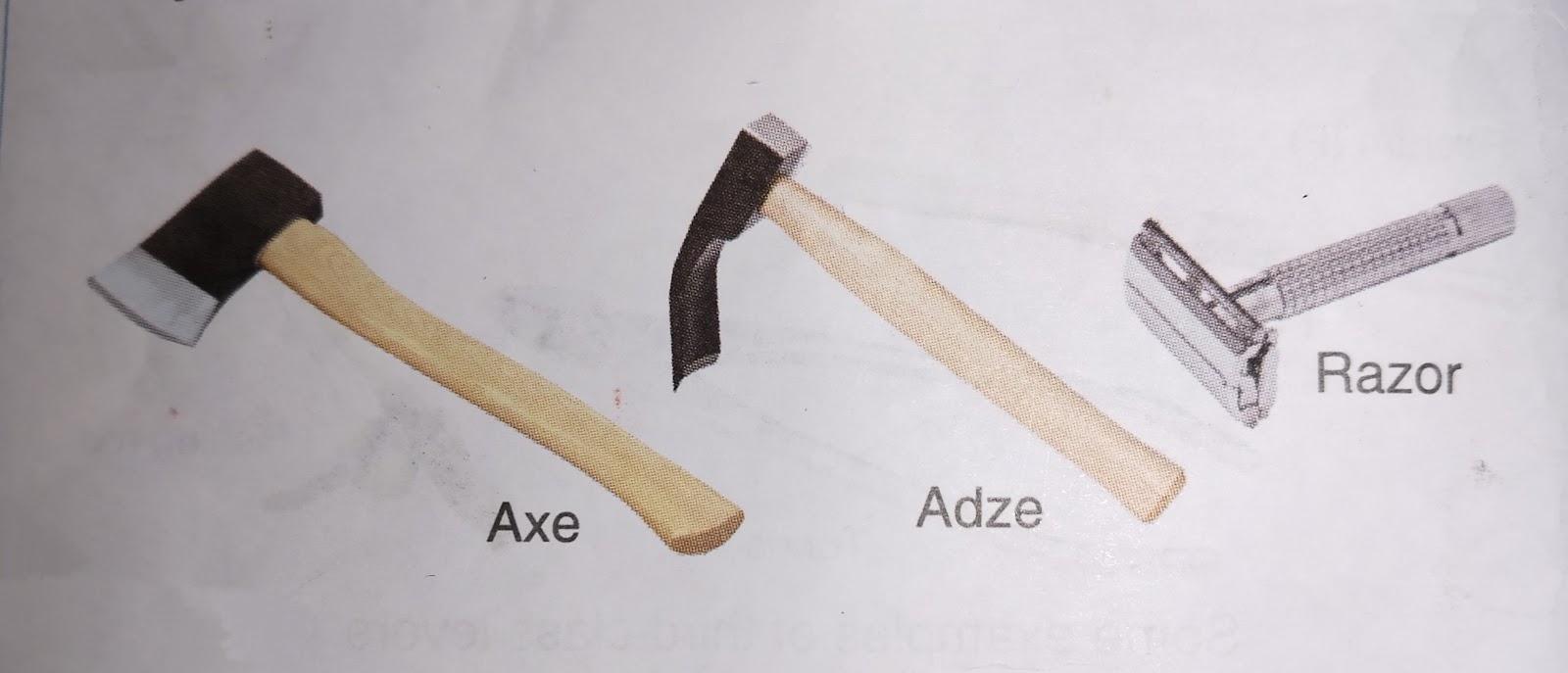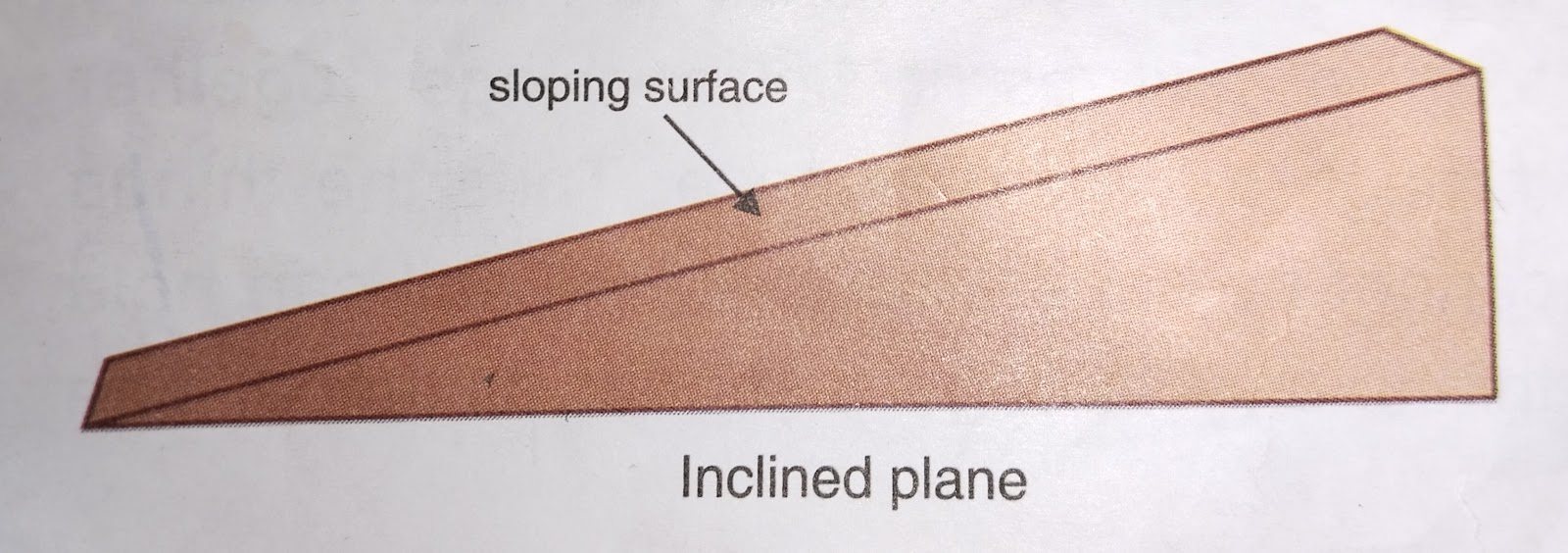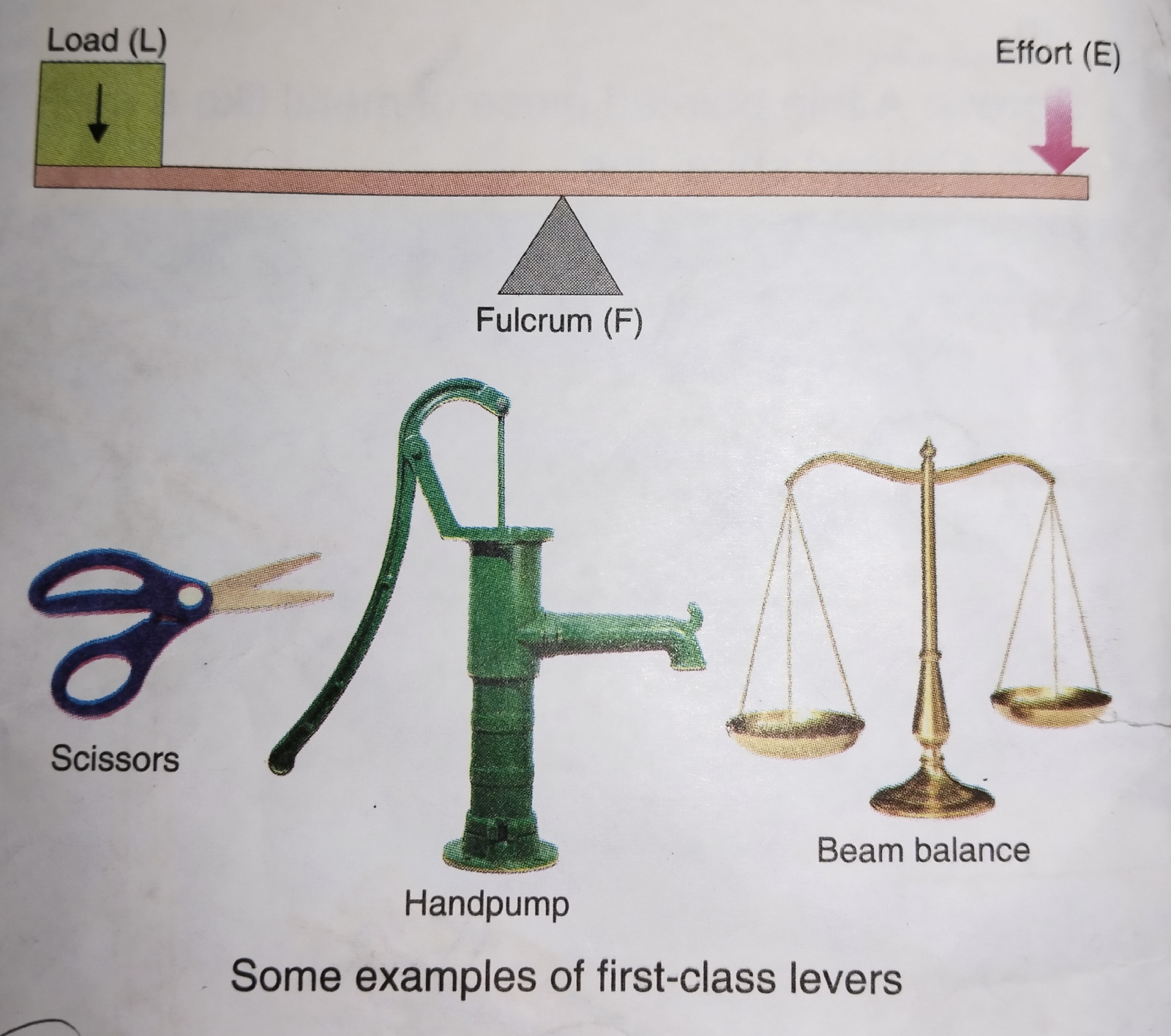Machines:
Tools which make our work easier is called Machine like Caesar and knife.
Machines are of two kinds
(1) Simple Machines and
(2) complex machines.
Simple machines
Simple machines are simple tools that we use in our day to day life.
Complex machines
Combination of two or more simple machines is called Complex machines.
Lever: A rigid bar which can turn around a fixed point is called Lever.
Fulcrum:
A fixed point around which a lever turns is called fulcrum. The force that we apply on the lever is called effort. The object to be moved by the liver is called load.
Types of Lever
On the basis of the position of load, effort and fulcrum, levers are generally of three kinds.
1. First-class lever: In which lever, fulcrum is in the centre of load and effort. Load acts on one end and the effort on the other end.
Like that Scissors, pliers, seesaw, handpump and beam balance
2. Second-class lever: In which lever, the position of the load is in the centre of effort and fulcrum. Effort acts at one end and the fulcrum on the other end. Like that pully.
3. Third-class lever: In which lever, effort is applied at the centre, load at one end and fulcrum is at the other end.
Forceps, fire tongs and a fishing rod are some examples of third-class levers
Pulley: A small wheel with a groove around its rim.
Fixed Pulley: A Fixed pulley has an axle in a Fixed block. A single Fixed pulley is supported by two parts of the same rope with mechanical advantage.
Movable Pulley: A movable pulley has an axle in a movable block. A single movable pulley is supported by two parts of the same rope and has a mechanical advantage of two.
Wheel and Axle
A wheel becomes a machine when it is attached to a rod or axle. A wheel with a rod fixed to it is known as wheel and axle arrangement.
Wheel and axle arrangement is used in steering wheels, bicycles, sewing machines, etc.
The wheel and axis arrangement helps us to turn something more easily by changing the direction of a force
Wedge
A wedge has two inclined planes, joined back to back with a sharp edge. It has a blunt and a sharp end. A wedge moves through an object. For example Knife, axe, shovel, adze and razor are examples of wedge.
Screw:
A thin pointed piece of metal like a nail with a raised spiral line and looks like a nail with grooves in it is called screw.
This winding edge of a screw is actually an inclined plane.
A screw is an inclined plane wrapped around a rod.
Thread
Screw has a winding edge called a thread. This winding edge of a screw is actually an inclined plane.
Inclined plane: Sloping surface is called Inclined plane. It is used to reduce the effort. Inclined plane is used to load heavy things at a high place.
Exercises
A. Tick (✔) the correct option.
1. This is used to hoist a flag.
a) inclined plane
b) pulley
c) lever
d) screw
Ans. b) pulley
2. Shovel, axe and adze are examples of
a) screw
b) wheel and axle
c) inclined plane
d) wedge
Ans. d) wedge
3. This is an example of third class lever.
a) Fire tong
b) bottle opener
c) scissors
d) wheel barrow
Ans. d) wheel barrow
4. Depending on the position of fulcrum, load and effort, this simple machine is of three types
a) pulley
b) wheel and axle
c) inclined plane
d) lever
Ans. d) lever
5. Which of the following is not a simple machine?
a) tricycle
b) fishing net
c) screw
d) pliers
Ans. a) tricycle
B. Fill in the blanks.
1. Levers are of .............. types.
2 A ............... has two inclined planes, joined back to back with a sharp edge.
3. An inclined plane is a ............... surface.
4. In a second-class lever, load is in the ...............
5. A machine makes our work ...............
Ans. 1. Three 2. Wedge 3. Sloping 4. Centre 5. Eassy
C. Answer these questions in one or two sentences.
1. What is a machine? Name some simple machines which we use in our daily life.
Ans. Tools which make our work easier is called Machine like Caesar, tongue and knife.
2. What is a screw?
Ans. A screw is an inclined plane wrapped around a rod.
3. What is an inclined plane? What is it used for?
Ans. Sloping surface is called Inclined plane. It is used to reduce the effort. Inclined plane is used to load heavy things at a high place.
4. What is a wedge? Give two examples of a wedge used at home.
Ans. A wedge has two inclined planes, joined back to back with a sharp edge.
For example Knife, axe, shovel, adze and razor are examples of wedge.
D. Answer these questions in detail.
1. What is a lever? Explain three kinds of levers with the help of a diagram. Lebel fulcrum, load and effort (F, L, E).
Ans. Lever: A rigid bar which can turn around a fixed point is called Lever.
Types of Lever
On the basis of the position of load, effort and fulcrum, levers are generally of three kinds.
1. First-class lever: In which lever, fulcrum is in the centre of load and effort. Load acts on one end and the effort on the other end.
Like that Scissors, pliers, seesaw, handpump and beam balance
2. Second-class lever: In which lever, the position of the load is in the centre of effort and fulcrum. Effort acts at one end and the fulcrum on the other end.
Like that pully.
3. Third-class lever: In which lever, effort is applied at the centre, load at one end and fulcrum is at the other end.
Forceps, fire tongs and a fishing rod are some examples of third-class levers
2. What is a pulley? Explain its types.
Ans. A small wheel with a groove around its rim.
Fixed Pulley: A Fixed pulley has an axle in a Fixed block. A single Fixed pulley is supported by two parts of the same rope with mechanical advantage.
Movable Pulley: A movable pulley has an axle in a movable block. A single movable pulley is supported by two parts of the same rope and has a mechanical advantage of two.
3. Explain any four types of simple machines.
Ans.
1. Lever: A rigid bar which can turn around a fixed point is called Lever.
2. Pulley: A small wheel with a groove around its rim.
3. Wedge : A wedge has two inclined planes, joined back to back with a sharp edge.
4. Screw: A screw is an inclined plane wrapped around a rod.
E. Given below is the list of activities. Name the machines used to do these activities:
1. Cutting paper.
2. Fixing two planks of wood together.
3. Drawing water from a well.
4. Unloading heavy drums from a truck.
5. Cutting an apple.
Ans. 1. Knife and scissor
2. Screw
3. Pully
4. Inclined plane
5. Knife












Post a Comment
Post a Comment